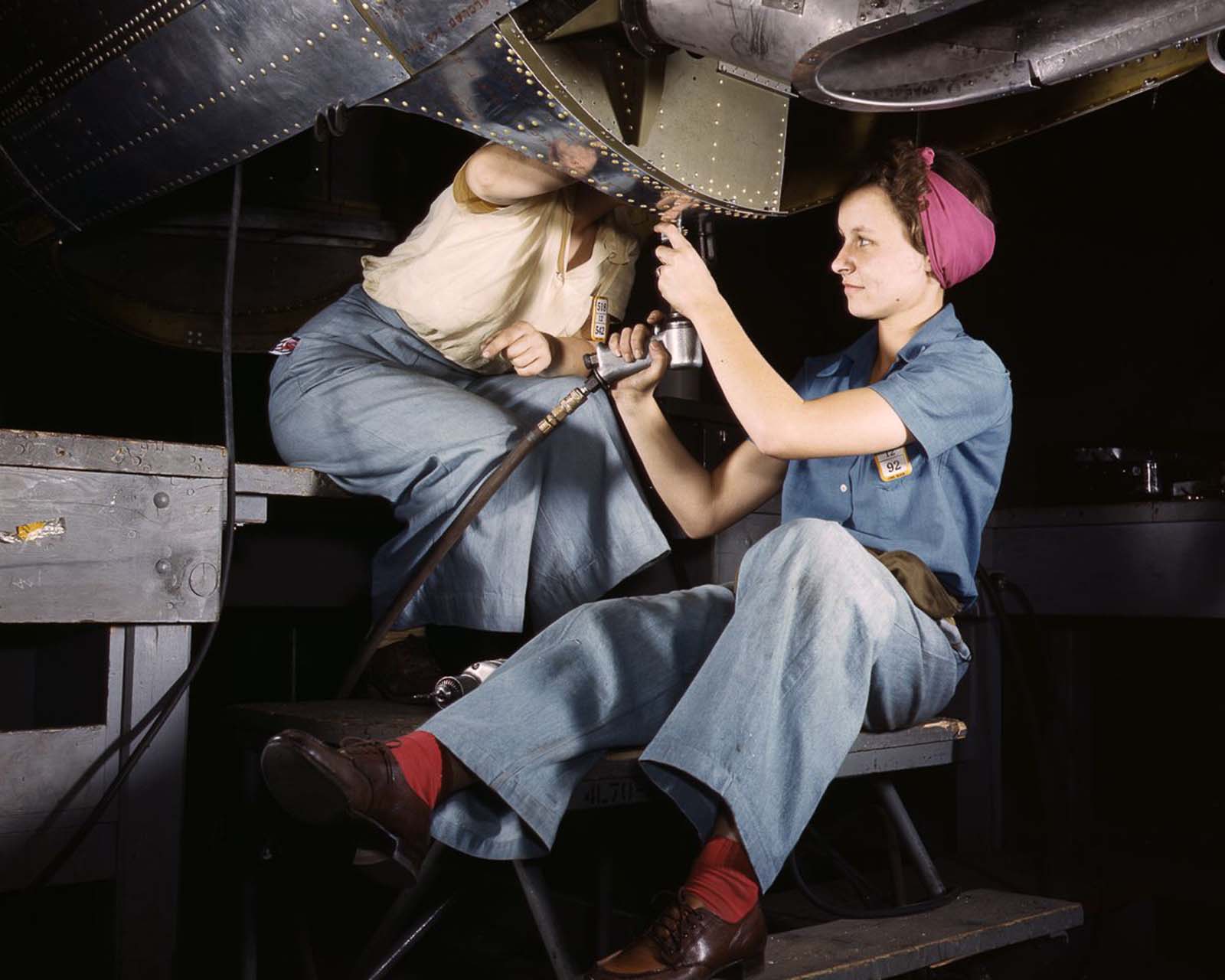
A worker assembles part of the cowling for a B-25 bomber motor at the North American Aviation plant in Inglewood, California. 1942.
More so than any war in history, World War II was a woman’s war. Women, motivated by patriotism, the opportunity for new experiences, and the desire to serve, participated widely in the global conflict.
Within the Allied countries, women of all ages proved to be invaluable in the fight for victory. Rosie the Riveter, a fictional American character, became the most enduring image of women’s involvement in World War II.
American women entered the workforce in unprecedented numbers during the war, as widespread male enlistment left gaping holes in the industrial labor force.
Between 1940 and 1945, the female percentage of the U.S. workforce increased from 27 percent to nearly 37 percent, and by 1945 nearly one out of every four married women worked outside the home.
More than 310,000 women worked in the U.S. aircraft industry in 1943, making up 65 percent of the industry’s total workforce (compared to just 1 percent in the pre-war years).
Office of War Information photographer Alfred T. Palmer visited several aircraft manufacturing plants, capturing the woman-led production in these colorful Kodachrome photos.

A worker irons at a factory for self-sealing gas tanks owned by the Goodyear Tire and Rubber Co. in Akron, Ohio. 1941.
Housewives who had never worked outside the home and single girls fresh out of high school were sent into newly created training courses to learn the basics of riveting—often the first job offered women— welding, and other jobs.
Experts speculate women were so successful at riveting because it so closely resembled sewing (assembling and seaming together a garment). However, riveting was only one of many jobs that women were learning and mastering as the aviation industry was developing.
As Glenn Martin, a co-founder of Martin Marietta, told a reporter: “We have women helping design our planes in the Engineering Departments, building them on the production line, [and] operating almost every conceivable type of machinery, from rivet guns to giant stamp presses”.

An electronics technician at the Goodyear Aircraft Corporation in Akron, Ohio. 1941.
Some women indeed chose more traditional female jobs such as sewing aircraft upholstery or painting radium on tiny measurements so that pilots could see the instrument panel in the dark.
And yet many others, maybe more adventurous, chose to run massive hydraulic presses that cut metal parts while others used cranes to move bulky plane parts from one end of the factory to the other.
They even had women inspectors to ensure any necessary adjustments were made before the planes were flown out to war often by female pilots. The majority of the planes they built were either large bombers or small fighters.
Although most Americans were reluctant to allow women into traditionally male jobs, women proved that they could not only do the job but in some instances, they did it better than their male counterparts.
For example, women, in general, paid more attention to detail. As the foreman of California Consolidated Aircraft once told the Saturday Evening Post, “Nothing gets by them unless it’s right.” The United States Department of Labor even states that when examining the number of holes drilled per day in the aircraft manufacturing industry, a man drilled 650 holes per day while a woman drilled 1,000 holes per day.

Riveters work on the cockpit shell of a B-25 bomber at the North American Aviation Company plant in Inglewood, California. 1942..
Other industries that women entered were the metal industry, steel industry, shipbuilding industry, and automobile industry. Women also worked in plants where bombs, weaponry, and aircraft were made.
While women’s contributions during the war were essential—they weren’t always treated fairly. Women workers often faced discrimination and harassment in the workplace, and they rarely took home more than half of what their male counterparts earned.
After the war, most women left their factory jobs as men returned to the workforce. But their role in supporting the war effort was not forgotten, nor was their role for the advancement of women in the workplace.

Inspectors examine wing parts of C-47 transport planes at the Douglas Aircraft Company plant in Long Beach, California. 1942.

A Douglas Aircraft Company employee does delicate electrical work on a plane at the plant in Long Beach, California. 1942.
Douglas Aircraft Company employees work on the belly of a bomber at the plant in Long Beach, California. 1942.

A Douglas Aircraft Company worker rivets an A-20 bomber at the plant in Long Beach, California. 1942.

Workers assemble a wing section for a P-51 fighter at the North American Aviation plant in Inglewood, California. 1942.

Workers feed sections of sheet metal through a pneumatic numbering machine at the North American Aviation plant in Inglewood, California. 1942.

A North American Aviation employee places metal parts on masonite before sliding them under a hydraulic press at the plant in Inglewood, California. 1942.

A North American Aviation employee assembles a section of the leading edge for the horizontal stabilizer of a plane at the plant in Inglewood, California. 1942.

A worker assembles switch boxes on the firewall of a B-25 bomber at the North American Aviation plant in Inglewood, California. 1942.

A machinist at work at the Douglas Aircraft Company plant in Long Beach, California. 1942.

Douglas Aircraft Company employees work an airplane motor at the plant in Long Beach, California. 1942.




